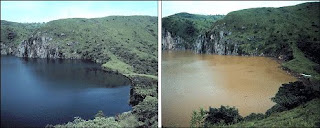One of my favorite parts of our class this semester has been
the focus on Universal Design for Learning. I happen to be a more traditional
learner in that I easily comprehend concepts that are spoken about or that I
write down, but there have been times in my classes where I simply don’t
understand what is put in front of me until I have tried several different
methods of thinking about it. It reminds me of finding my way through routes I
traveled in my childhood – I didn’t know to pay attention to the names of roads
or buildings we traveled by, and I would be hard-pressed to find my way solely
through those names now. But I have very vivid memories of what the route
looked like, where we turned, and how long it took to get there. So for traveling,
I use spatial and visual learning. Imagining what would happen if I had to take
that very clear mental map and write a set of directions using only street
names, and for a grade, makes me sympathetic towards students who have a hard
time translating a lecture into solid ideas.
The Common Core Standard #5 in Speaking and Listening - CCSS.ELA-Literacy.CCRA.SL.5
Make strategic use of digital media and visual displays of data to express
information and enhance understanding of presentations – most succinctly states
the need for UDL principles and the ways in which digital media can help
accomplish them. Despite the tendency to fall back on PowerPoint slides and
lectures, there are as many ways to express information as there are children
to learn it, and varying those ways of expression is the best way to ensure all
the students in a class can follow your lesson. Even more, the various tools
available can help students organize and present their own ideas in a way that
makes sense to them. Using tools like Popplet to make intricate concept maps or
Scoop.it to collect their resources can encourage students who have a fear of
the blank sheet of paper to be confident in what they are planning. I was
especially excited to see all the games and animations that were presented,
because there are many people who learn by doing things and taking ideas apart
to see how they work. To a first-grader who is very tactile and would rather be
playing with LEGOs, the idea that you can make an animation in Scratch by
moving around colored blocks of text is revolutionary. And getting up to move
around and film things with Videolicious successfully captures the attention of
children with ADHD and kinesthetic learners.
Overall, I have enjoyed the many and various tools I learned
about in this class. I am not likely to go into education any time soon, but
everybody winds up in the role of teacher or student at some point, and I often
end up teaching the use of technology to various people at the public library
where I work. When I do, I keep in mind the principles of UDL and try to
teach the person in a way they can understand. I hope to take these ideas
through the rest of my career.




